Śrī Vinoda-bihārī Prabhu's Santoṣa
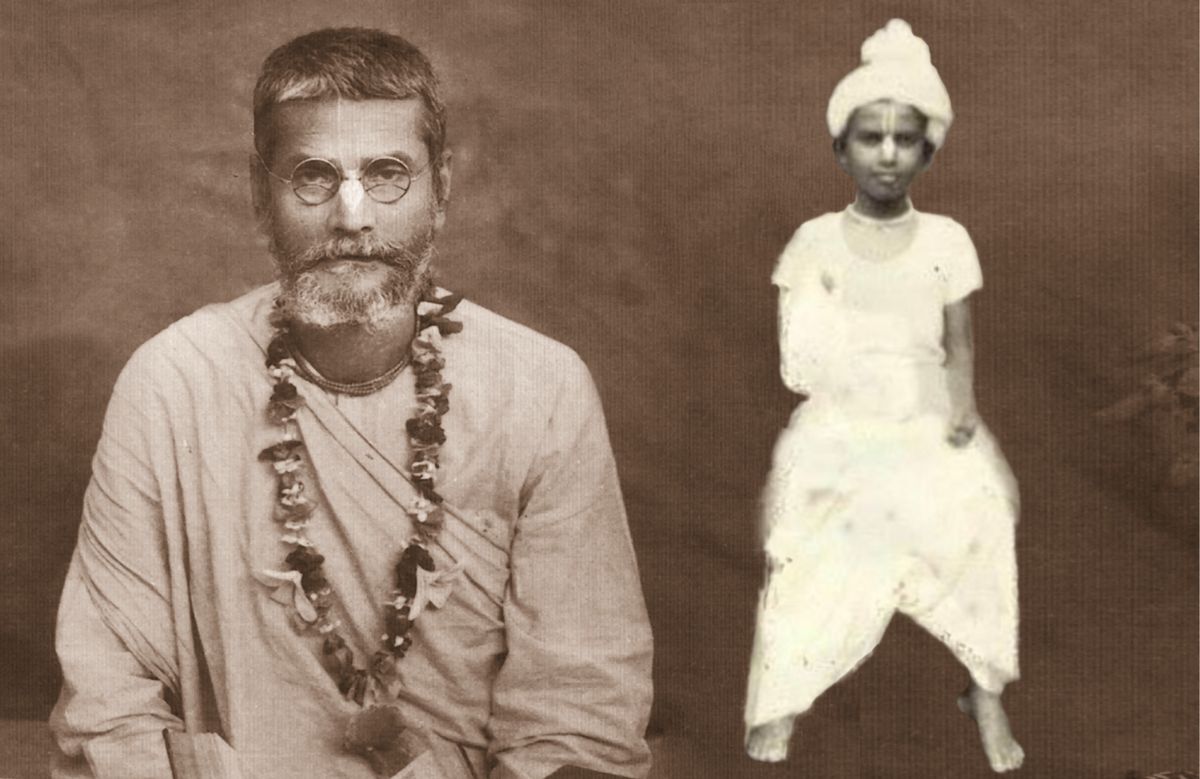
On Śrīla Bhaktivedānta Vāmana Gosvāmī Mahārāja's Vyāsa-pūjā twelve days ago, a beautiful 100-page booklet was published in Hindi containing devotees' sweet remembrances of him. Having nearly finished reading it, I'm feeling inspired today to share a few stories from his early life that our Rays of The Harmonist team translated into English in honor of his centennial appearance day. Maybe someday we'll translate the full booklet (or at least many more remembrances from it). 🙂
Pūjyapāda Bhaktivedānta Vāmana Mahārāja’s early life in the maṭha
(Excerpt from a lecture by Śrī Śrīmad Bhaktivedānta Nārāyaṇa Gosvāmī Mahārāja given on 29 December, 1991. Published in A True Servant, A True Master – Pg. xxvii)
Śrīla Prabhupāda was in this rūpānuga guru-paramparā and he had many associates. In a very short time, they preached throughout the whole world the message that was practised and preached by Śrīman Mahāprabhu. Of them, my gurudeva, nitya-līlā-praviṣṭa oṁ viṣṇupāda Śrī Śrīmad Bhakti Prajñāna Keśava Gosvāmī Mahārāja was foremost, and he [Śrī Śrīmad Bhaktivedānta Vāmana Gosvāmī Mahārāja] is his foremost disciple. Some identify with their families, with their mothers and fathers, but his identity was as a disciple of our guru mahārāja. His mother was a disciple of Śrīla Prabhupāda. Her name was Śrīmatī Bhagavatī-devī. His father was a disciple of our guru mahārāja. Almost everyone else in his family – his brothers, his father, and most of his uncles – was a disciple of Guru Mahārāja. His mother, however, had taken shelter of Śrīla Prabhupāda before any of them. She entrusted pūjyapāda Vāmana Mahārāja into the care of our guru mahārāja at a very young age.
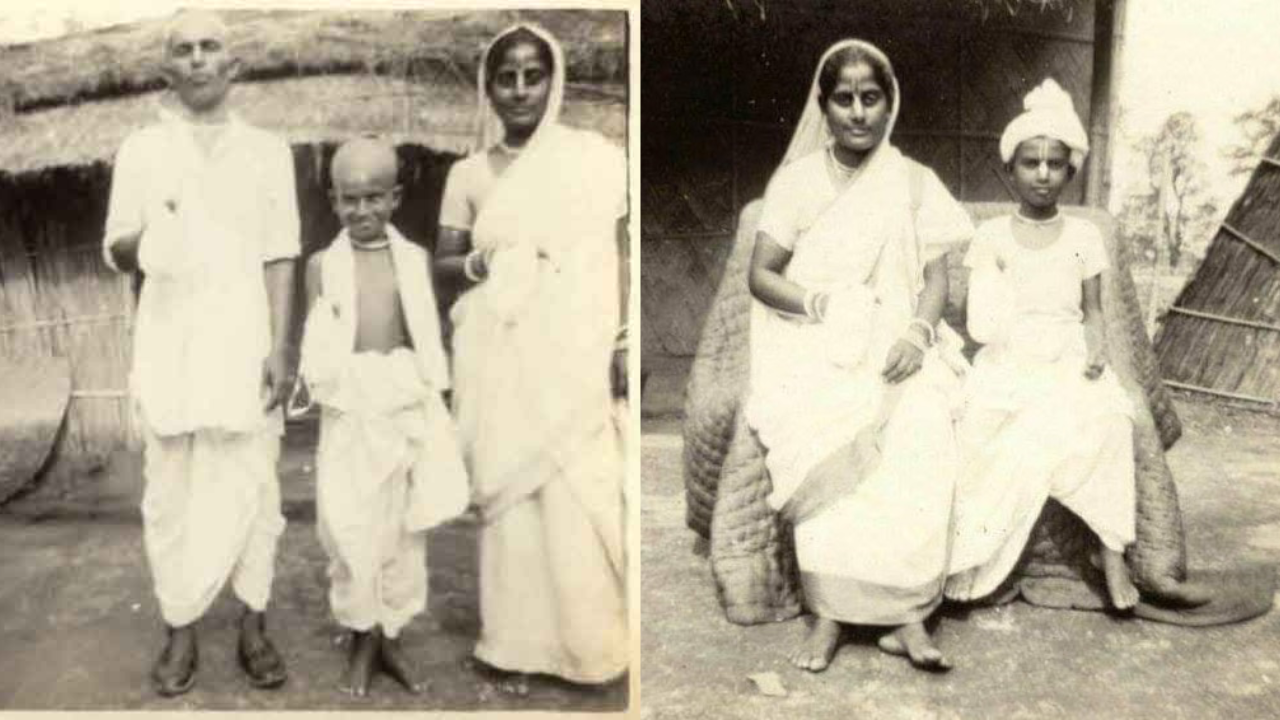
Guru Mahārāja was like his father, and Śrī Narahari Prabhu, known as the mother of the Gauḍīya Maṭha, raised and nurtured him. Even if some of the boys wet their beds at night, Narahari Prabhu would clean it up. He would make sure they all got to bed on time, and then he would wake them up in the morning and bring them to maṅgala-ārati. He fed them and taught them how to read and write. He took care of everyone very lovingly. That is why there were so many people in the maṭha back then. People will only be attracted to guru if he gives them more love than they receive from their families and the rest of the world. Therefore, guru has to be loving like this. Then he can attract everyone.
Pūjyapāda Vāmana Mahārāja’s childhood name was Santoṣa. He was originally from the Khulna district, but he was raised here in the Gauḍīya Maṭha. Guru Mahārāja enrolled him in the Bhaktivinoda Institute. Guru Mahārāja taught him everything. He would give Santoṣa a “lemon juice” (candy) for every verse he memorized, so he would memorize up to a dozen verses or more a day. He lived in the āśrama [at Śrī Caitanya Maṭha] and went to school there [at the Bhaktivinoda Institute next to Yogapīṭha]. There were many other boys who went to school with him, but none of them remained brahmacārīs or took sannyāsa. Most of them left. A few remained.
From childhood, pūjyapāda Vāmana Mahārāja had a profound love of learning, but he also served. He would set plates for everyone, set their āsanas, put salt and lemon on their plates, sweep and clean up after prasāda, bring everyone drinking water for the day, and also cut and prepare the vegetables for cooking. This is one of the main services in a Vaiṣṇava temple – cutting vegetables. He was so quick at cutting vegetables, you cannot imagine. You would look away for a moment, and chop, chop, chop, he would be done, and every piece would be the exact same size, none too big or small.
Coming to Māyāpura and serving the Vaiṣṇavas
(Excerpt from the Introduction to Śrī Śrīmad Bhaktivedānta Vāmana Gosvāmī Mahārājer Prabandhāvalī, 2006. Published in A True Servant, A True Master – Pg. 411)
From childhood, Śrī Santoṣa was very calm, humble, loyal, and extremely bright. He had just graduated from the fifth grade when he came to know that some devotees from his village were going to participate in Śrī Navadvīpa-dhāma parikramā and Śrī Gaura-jayantī. Feeling his eternal attraction to the holy dhāma, he expressed his desire to go with them to Śrī Māyāpura. Since there already was a very spiritual atmosphere in the home and, on top of that, since they all adored Santoṣa, no one was going to forbid him from going. Moreover, the pilgrimage only lasted a few days. Santoṣa was therefore permitted to go to Śrī Māyāpura with his aunt, under the guidance of Śrī Viṣṇupāda Dāsādhikārī “Bhakti-sindhu” Prabhu, who served as an organizer for the pilgrims from their village. It was the year 1931 and the boy Santoṣa was all of nine years old.
It was during this time that his uncle, Śrī Vīrendra left his job as a surveyor at the Government Survey Office and took up residence at the maṭha in Śrī Māyāpura. Santoṣa performed parikramā of all the nine islands of Navadvīpa with his aunt and uncle and continually heard hari-kathā from Śrīla Sarasvatī Prabhupāda and his disciples. He also came into the proximity of Śrī Caitanya Maṭha’s magnanimous temple president, Śrīla Narahari Sevā-vigraha Prabhu, popularly known as Mā (mother), and the maṭha’s estate manager, Śrī Vinoda-bihārī Kṛtiratna Prabhu, and became the object of their profuse loving blessings.
That year, on Śrī Gaura Pūrṇimā day, Śrīla Sarasvatī Prabhupāda inaugurated Śrī Bhaktivinoda Institute, which had been founded on the initiative of Śrī Vinoda-bihārī Brahmacārī Prabhu. Seeing all this, the boy Santoṣa quietly made a vow to not return to his home. Feeling he had found his own true place and his real guardians, there was no question in his mind of returning to an ordinary worldly life. Pursuit of the ultimate goal of life was his eternal inclination. To follow the associates of Śrī Gaura was his dharma.
At the end of the parikramā, when everyone was returning to their homes, the boy Santoṣa would not go. His aunt was thunderstruck. What to do? No matter how much she pleaded, how much she tried to reason with him, it was all in vain. He would not budge. Finally, his uncle Śrī Vīrendra Prabhu took the boy’s side and persuaded his sister to return home.
Distressed at the news, his parents rushed to get him. However, the boy’s resolve was as immovable as a mountain. Despite all their tears and anguish, nothing could sway him. Śrī Vīrendra Prabhu consoled them. “Santoṣa can stay here and go to school. A new secondary school has been started here and he will be able to receive both spiritual and material education. You can come to visit from time to time and see him. He will not have any inconvenience here. Once he finishes his studies, I will convince him to go home.” With these assurances and those of Śrī Narahari Prabhu and Śrī Vinoda-bihārī Prabhu, Santoṣa’s parents were persuaded to let him stay there.
Thus, the boy Santoṣa began to reside at Śrī Caitanya Maṭha with great delight and no desire to return to his hometown. Nothing could make him falter in his resolve for even a moment, not even missing his parents or his doting aunt. He did not seem to miss his friends or his toys or the pony he used to love to ride. He felt that Śrī Gaurasundara’s birthplace, Śrī Māyāpura, was his true home and that Śrī Bhaktisiddhānta Sarasvatī Prabhupāda and his associates were his real family members.
Śrī Vinoda-bihārī Prabhu arranged for him to be enrolled in the Śrī Bhaktivinoda Institute. There, his teachers quickly became very fond of him because his intellect was so sharp. He could memorize a textbook just by listening to it being read out loud. Everyone was amazed. He could listen to Śrīla Prabhupāda’s hari-kathā and repeat it word for word. Śrīla Prabhupāda himself would become delighted to hear this charming boy repeat his lectures verbatim. Santoṣa thus quickly endeared himself to Śrīla Prabhupāda and his learned disciples.
The boy Santoṣa had another special quality, however, which was his sincere inclination to serve. It was because of this quality in particular that he won all their hearts. Every day, early in the morning during brahma-muhūrta, before anyone was awake, he would wake up with Śrīla Narahari Prabhu and perform a variety of services incognito and in a very beautiful manner. These services ranged from cleaning the toilets, picking flowers from the garden, cutting and preparing vegetables, cleaning the sannyāsīs’ and brahmacārīs’ rooms, washing their clothes, hanging the clothes to dry and later, folding and delivering them to their owners, refilling the pots of drinking water in all the rooms, polishing the ācamana cups, and so on. There was not a sannyāsī or brahmacārī who lived in Śrī Caitanya Maṭha during that time that he did not serve.
It was this wholehearted and remarkable propensity for service that Śrīla Prabhupāda and the bearers of his divine message, his disciples, recognized as an indication of Santoṣa’s eternal nature. It was this that made them count him as one of their own. Śrīla Prabhupāda was very pleased to see the sincere service tendency of this little boy and the fact that he had memorized Gītā and Vedānta-sūtra in their entirety. When Śrīla Prabhupāda was in Māyāpura, Santoṣa would always be around him. He would wash Śrīla Prabhupāda’s clothes, massage his feet, pick fresh green chickpeas from the garden, shell them, and offer them to Śrīla Prabhupāda. In August of 1936, Śrīla Prabhupāda, being pleased with Śrī Santoṣa, granted him harināma mahā-mantra. Śrīla Vāmana Gosvāmī Mahārāja would sometimes say, “I was possibly the last person to receive harināma from Śrīla Prabhupāda.”
“Narahari Prabhu would gently shake me awake”
(Memory from Śrīpāda B. V. Siddhāntī Mahārāja of Śrī Devanānanda Gauḍīya Maṭha. Published in Rays of The Harmonist online – Fortnightly Centennial Edition, Issue 27)
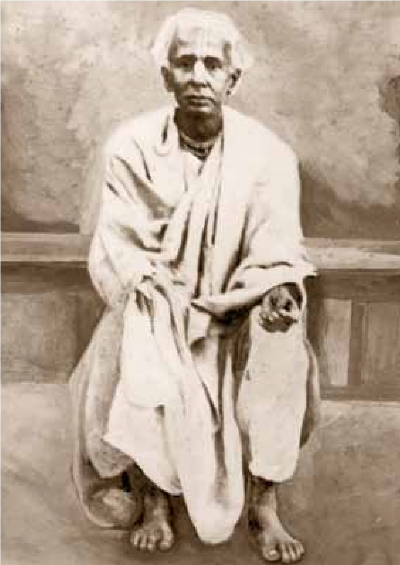
An example of how to conquer the heart of guru and Vaiṣṇavas is seen in the life of Śrīla Guru Mahārāja – Śrīla Vāmana Gosvāmī Mahārāja. Every day at midnight, Narahari Sevā-vigraha Prabhu would awaken the sevaka Santoṣa from his sleep.
In Śrīla Guru Mahārāja’s words: “I would be quietly and gently shaken awake, and I’d understand that Narahari Prabhu had come. Immediately rising from bed, I’d put on a gāmchā and follow behind him to the many toilets, one toilet after another. Narahari Prabhu would hold the torch and I would take a broom and a bucket of water and clean each toilet. At that time, there was a latrine pit system. I used to empty the toilet pit filled from the previous day and throw all the stool to the designated place far away, cover it with dirt, and return. Then, after taking bath, I would rest a little. This was my daily service, and I would do it before all the Vaiṣṇavas arose.”
The special type of guru-sevā performed by Śrīla Narottama Ṭhākura was performed by our Guru Mahārāja daily during the time he lived in Śrī Caitanya Maṭha.
“You have only one parama-gurudeva, not two”
(Memory from Śrīpāda B. V. Tapasvi Mahārāja. Published in Rays of The Harmonist online – Fortnightly Centennial Edition, Issue 25)
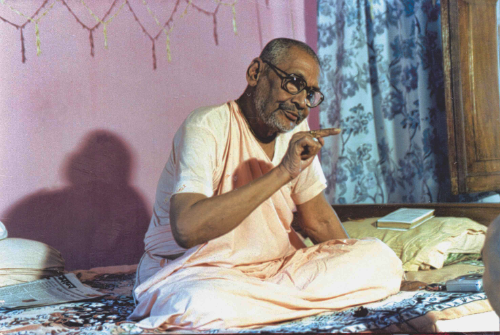
Once, I asked Guru Mahārāja – Śrīla Vāmana Gosvāmī Mahārāja – “Guru Mahārāja, we [your disciples] have two parama-gurudevas, don’t we?”
He was surprised to hear this: “Two parama-gurudevas!” he exclaimed. “Tell me, who?”
With some hesitation I said, “One is Śrīla Bhakti Prajñāna Keśava Gosvāmī Mahārāja [your dīkṣā-guru] and the second is Śrīla Bhaktisiddhānta Sarasvatī Ṭhākura Prabhupāda [your harināma guru].”
I had a keen desire in my heart to also call Śrīla Prabhupāda parama-gurudeva, because it was from him that my Guru Mahārāja had received harināma. Ah! If I could call Śrīla Prabhupāda parama-gurudeva, it would be a matter of great pride. At least from the perspective of what took place, I could certainly call him that, but what if Guru Mahārāja didn’t permit us to do so? Then my doing so would be disastrous. That was my fear. I contemplated this in that manner and eventually raised this concern to Guru Mahārāja.
Guru Mahārāja immediately understood my mood. In a peaceful manner, he replied. “You all have only one parama-gurudeva, not two. Simply because of one incident, you are thinking like that, but that alone is not sufficient. Śrīla Prabhupāda cannot be your parama-gurudeva because I cannot seat him on the āsana of being my guru-pādapadma. My guru-pādapadma is Śrīla Bhakti Prajñāna Keśava Gosvāmī Mahārāja and his guru-pādapadma is Śrīla Bhaktisiddhānta Sarasvatī Ṭhākura Prabhupāda. That is it. There is nothing more than that. Once, I clearly expressed this very matter to my guru mahārāja [Śrīla Bhakti Prajñāna Keśava Gosvāmī Mahārāja].”
Saying this, Guru Mahārāja narrated an incident from his own life:
“It happened when our press [Gouranga Printing Works] shifted from Kolkata to Śrī Uddhāraṇa Gauḍīya Maṭha, in Chũchurā. One day I was working at a desk, absorbed in preparing an article for printing. Nearby, Guru Mahārāja was resting on his easy chair. There was no one else present. Suddenly, I heard Guru Mahārāja say, ‘O guru-bhāi!’
“Hearing this, I wondered, ‘Let me see which of Guru Mahārāja’s guru-bhāi (god-brother) he is calling for. I will first call for him and then resume my work.’ Thinking like this I asked Guru Mahārāja, ‘Who has come, Gurudeva? Who are you calling?’
“ ‘No one else is here,” he said, “I am calling you.’
“Surprised, I asked, ‘Am I your guru-bhāi?!’
“ ‘Why not?” he replied. “You have received harināma from Prabhupāda, so you are indeed Prabhupāda’s disciple.’
“Hearing these words deeply pained me. I said, ‘It may be that I have received harināma from Prabhupāda, but I am not his disciple. You are the disciple of Prabhupāda and I am your disciple. I have never thought of myself as one sheltered by Prabhupāda. You alone are my shelter, and I trust this much only. Now you are calling me guru-bhāi. Does that mean I am not your sheltered one (āśrita)? If so, I have become shelterless. I have seen in an article by Śrīla Bhaktivinoda Ṭhākura that mantra-dīkṣā-guru is actually śrī nāma-guru. Therefore, you alone are my nāma-guru, and I am your disciple in every respect. You have called me your guru-bhāi. Do you now want to push me away from being under your shelter? O Gurudeva, these words have greatly pained me.’ I put my head down on the table, between my two arms, and started weeping.
“At that time, Gurudeva stood up from his easy chair and came over to me. Stroking my head with his hand, he said, ‘I was simply joking with you. You are indeed my disciple. All right, I will never again call you guru-bhāi. You are not the disciple of Prabhupāda; you are indeed my disciple, my sheltered one. Don’t be disheartened anymore.’
Then my Guru Mahārāja [Śrīla Vāmana Gosvāmī Mahārāja] said to me, “I hope you understand why I have told you of this incident. You all do not have two parama-gurudevas, only one, and he is jagad-guru Śrīla Bhakti Prajñāna Keśava Gosvāmī Mahārāja.”
In this way, Guru Mahārāja declared his firm siddhānta.
Hearing this I was astonished. What amazing guru-niṣṭhā Guru Mahārāja has! He never mentioned his receiving harināma from Śrīla Prabhupāda in an assembly or before any individual. Considering himself a disciple of Śrīla Prabhupāda would have put him on the same level as Śrīla Keśava Gosvāmī Mahārāja, and he never maintained such an identity (abhimāna).
I think that Parama-gurudeva’s joke with Guru Mahārāja, was actually not a joke but a test. Param-gurudeva wanted to see Guru Mahārāja’s inner steadfastness (antara-niṣṭhā).
Guru Mahārāja had received harināma from Śrīla Prabhupāda, and therefore he is disciple of Śrīla Prabhupāda. Was it appropriate or not for Parama-gurudeva [Śrīla Keśava Gosvāmī Mahārāja] to consider Śrīla Prabhupāda’s disciple his own, simply because he had given Guru Mahārāja dīkṣā-mantras? To test him, he playfully addressed Guru Mahārāja as guru-bhāi. By this, he saw evidence of Guru Mahārāja’s inner steadfastness and that his ‘Sajjana-sevaka’ is one hundred percent his disciple. Therefore, without a doubt, Guru Mahārāja’s has one gurudeva, not two.
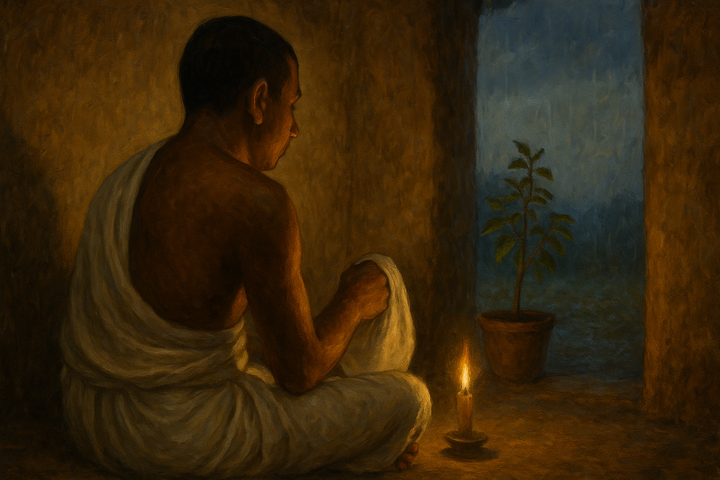
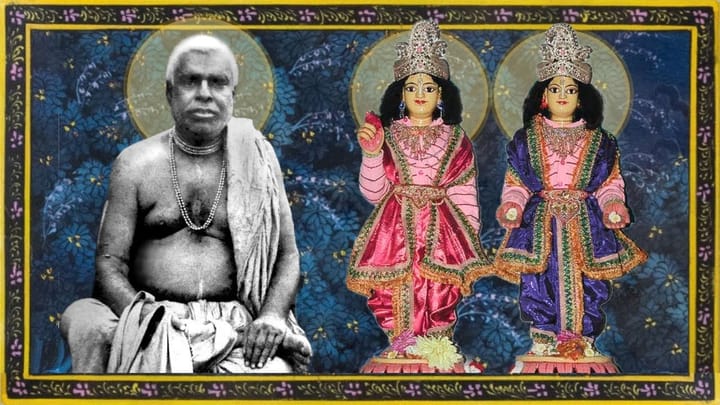
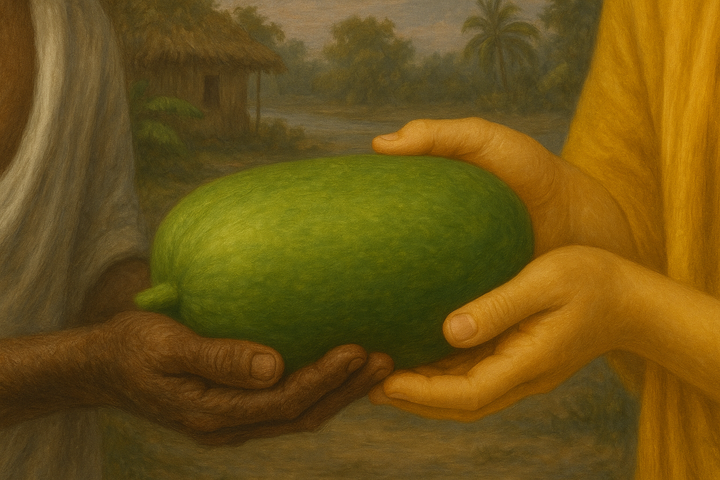
Comments ()